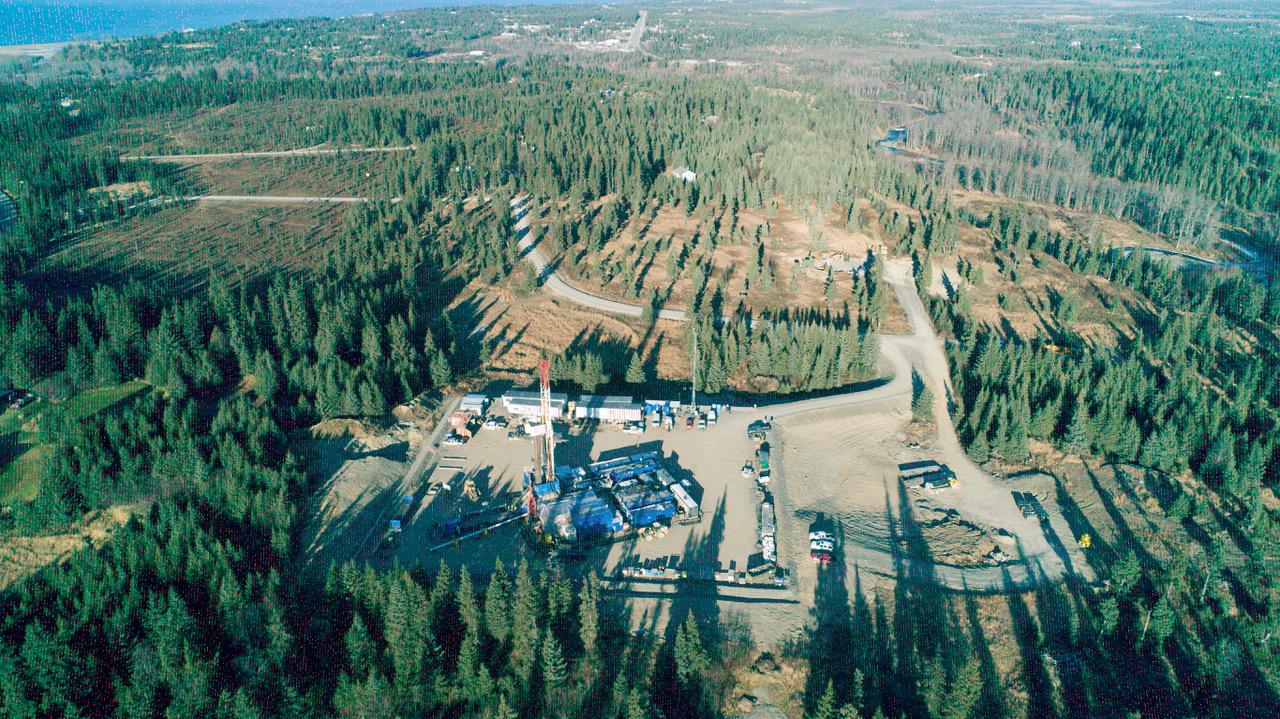
Earlier this fall, Hilcorp began exploring for natural gas and oil in an Anchor Point neighborhood where many own their mineral rights. That’s making it difficult for some residents and landowners near the drill site to get information about the project and any future plans Hilcorp may have.
About a month ago, Lorri Davis woke up to a strange noise.
“I was laying in bed the other night. I thought what in the world is that? They had just put it up, and when I opened the back door, I thought, oh yea, there it is,” Davis recalled. “You can hear it constantly.”
What she was hearing was a drill rig owned by Hilcorp exploring for oil and gas about a quarter of a mile from her home in Anchor Point. She says it sounds like a dump truck is parked in her driveway.
Sarah Spencer lives in the same neighborhood and she had a similar experience.
“I saw it. The lights are very bright and very tall, and my first concern was my well water, whether that would be affected by the drilling so close by,” Spencer explained.
Spencer said Hilcorp has done little to assure that her well will be unaffected.
However, Spencer and many of her neighbors knew this was coming. The Alaska Department of Natural Resources had to permit the drill site because Hilcorp is drilling through state land on the way to the private subsurface it’s exploring.
Hilcorp applied for an exemption to a state law limiting how close oil and gas wells can come to unleased private subsurface property. Spencer received a notice about that.
Spencer and her neighbors initially found out that Hilcorp planned to explore the area through company representatives asking them to lease their land over the past few years, so the company could explore for oil and gas below their land from the drill site in the neighborhood.
Spencer said the lease was complicated, and she was worried about what she would be agreeing to.
“They were just like, well, everybody is doing it, everyone is signing it. So, you should sign it too,” Spencer said. “I felt like I couldn’t get enough information to feel like I was comfortable to sign that document.”
Spencer owns the mineral rights to her land because her property was homesteaded prior to statehood, which means she has control of all resource
extraction on her property. Many of her neighbors also own their mineral rights and that makes her nervous.
“If you’ve got somebody next door to you who’s wanting to develop something, you don’t necessarily have the right to go over and say, hey, what are you guys doing?” Graham Smith, who works for DNR’s Division of Oil and Gas, explained. “To a certain extent, it’s their land, it’s their business.”
He said this scenario is common on the Kenai Peninsula.
“It’s one of the first regions of the state to have oil and gas development, and it’s also one of the first regions to become heavily populated in that region,” Smith added. “Those two things happened sort of happened concurrently.”
That muddies the public process. A private landowner with mineral rights can lease their land to Hilcorp as a drill site or lease just the subsurface of their land without any requirement to tell their neighbors.
Smith adds that public information about oil and gas exploration on private land comes with a lot of what ifs.
Oil and gas wells themselves are permitted internally at the Alaska Oil and Gas Conservation Commission, and the location of wells is only made public after they are approved.
Other information can spring from peripheral development. For example, Hilcorp may need permits to build roads from the Army Corps of Engineers or a water usage permit from DNR. Each permit could provide snippets of information about Hilcorp’s plans.
“There’s certainly no template or boiler plate to which we can refer to,” Smith said. “A lot of times we just have to judge it on its merits and take it on a case by case basis.”
What Hilcorp might do in Spencer’s neighborhood is unclear. The company said it will assess its findings from the current well it’s drilling before it moves forward with more development in the Anchor Point area, though DNR’s permit for the drill site indicates it plans to drill a second well.
Late last month, Hilcorp leased five parcels on the western end of Anchor Point from the Kenai Peninsula Borough, and it indicated it had agreements with private landowners surrounding those properties.
That’s setting up a potential regulatory maze for landowners like Spencer who want to track any potential development Hilcorp has planned.
“I’m worried about it, but at the same time I feel like there’s nothing I can do because I can’t stop them from drilling. I don’t think any of us can. The borough can’t,” Spencer said. “If a private landowner allows them to drill on their property, then they can do it.”
It’s not just her well water she’s worried about. It’s how development might affect her property value or just how the character of the town, known for its sport fishing opportunities, might change.
She said it’s left her feeling hopeless.




